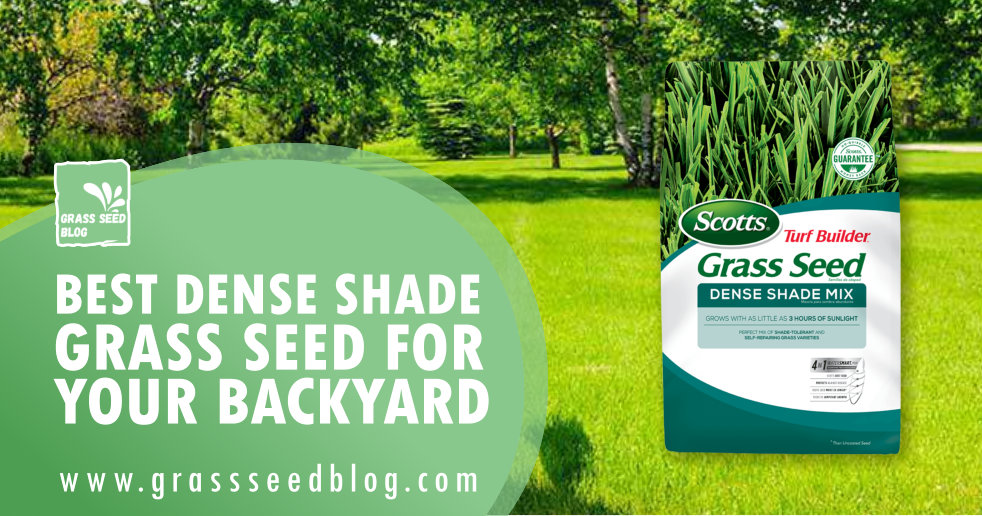Growing dense shade grass seed can be quite challenging. Most people would dream of having a lush, beautiful lawn with big trees to provide a lovely shade during summer time. However, what they do not realize is that the cozy shade is preventing the garden from growing the lawn properly.
Like most plants, grass also requires sunlight to grow. Even the shade-tolerant type of varieties will still need some sun. Therefore, if you would like to have a very dense tree foliage that covers an area completely throughout the day, be prepared as the grass is very unlikely to be able to grow properly in that shady area.
But if the shaded area in your garden can reach the sunshine for some part of the day, you can still grow grass by choosing the right types of seed variety.
What Kind Of Grass Grows In The Shade
What kind of grass grows in the shade, able to keep your green lawns immaculate and with no sparse or bald spots? What you need is a shade-tolerant variety of grass seed.
When planting the seed in any shady area, you should go with a grass type that is equipped with excellent shade and disease tolerance. This is the most important step when trying to combat shady areas. Grass seed selection! Fine fescue has the highest shade tolerance, however, if you are located in an area like Florida, fine fescue isn’t a solution as it’s a cold season grass. If searching for a warm-season grass variety that is shade tolerant, St. Augustine grass is about your only selection. Tall fescue grass has decent shade tolerance and Kentucky bluegrass, and perennial ryegrass varieties are considered to have fair shade tolerance.
A thick stand of grass will not survive well in low light. Therefore, if you are planting grass seed in the shade, it is best to plant during autumn when tree foliage is gone. But plant with a lower seed rate. This is because normal seed rates in shady areas will generate too many grass plants which will cause undesirable establishment.
The best way to keep your green lawns looking that way would be to grow your grass a little longer in the shade than in the parts that get a good deal of sun. You’ll need each grass plant to have more surface area to collect light to photosynthesize with. Not only are grasses in shady areas hard up for light, but they also need to struggle a bit for the water they need – they will have the trees they are under sucking up all the moisture. All you need to do is to water any part of your lawn under a tree a little bit more. Keep scattering those mixed seeds over the shady part of your garden until it begins to take root, and you should be able to relax.
Scotts Dense Shade
A specially mix of shade-tolerant and self-repairing grasses, Scotts Dense Shade Mixture is a very suitable combination of seeding for around or under dense trees areas. This low maintenance lawn mix does not require a lot of sunlight, as it can grow with as little as 3 hours of sunshine. Each seed contains their unique WaterSmart PLUS Coating which can absorb 2 times more of water than uncoated seed. It is fed with essential nutrients to jumpstart growth and can protect the seedlings against disease. Overall, it can grow faster, thicker and produce better greener grass.
Shady Nooks Grass Seed
Shady Nooks Grass Seed is specially made to survive in poor dry soils, moist soil, or in heavily shaded areas. It is enhanced with Endophyte to improve insect resistance. It has Hard Fescue turfgrass which requires very little fertilizer. It also contains Poa Trivialis, which is a shade tolerant grass that thrives well even in damp, shady places. One pound of this mix can cover up to 750 square feet area.
Shade Tolerant Ornamental Grasses
Although most ornamental grasses prefer full sun, there are some shade tolerant ornamental grasses that can grow well and provide interest to shaded areas in the garden.
Tufted Hair Grass – Deschampsia cespitosa
This is a dark green clump forming grass. It blooms silky green flower panicles during spring time while maturing to yellow, gold or bronze during the fall season. It thrives best in a moist partial shade. It can grow up to 2 to 3 feet tall.
Northern Sea Oats – Chasmanthium latifolium
This variety has a bamboo-like appearance. It produces very attractive seed heads in late summer or early fall. It will grow in full shade up to 2 or 3 feet. It reseeds very heavily.
Japanese Forest Grass -Hakonechloa macra ‘Aureola’
This species produces elegant arching clumps of lime green foliage. It is reddish in color during autumn. Slow in growing, it is best suited in shaded parts.
Sedges – Carex sp.
These are a numerous useful species offering attractive foliage coloration. Some are clump forming while others spread readily. It is tolerant also of moist to wet conditions. It grows well in part to full shade.

